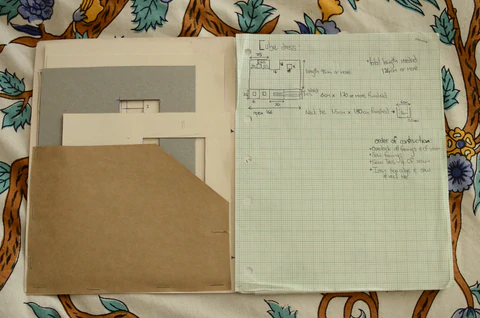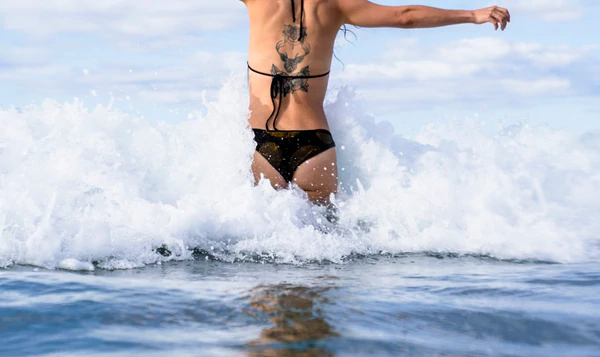Surfing to Zero Waste by Emma La Rocca
- ZWDO Collective

- Apr 30, 2022
- 4 min read
Kia Ora, my name is Emma La Rocca (@emroceswimwear). I'm from New Zealand and I make surf friendly, zero waste swimwear using Econyl Renew prime fabric. I design, cut, and sew everything for my brand emroce, often with the help of amazing, incredible interns from around the world. I see my work with emroce as testing the waters so that larger companies will take it on as proof that zero waste design methods do in fact create cheaper and more environmentally-friendly fashion.

Journey to Zero Waste
I studied Fashion Design at Massey University for 4 years from 2006 and it was there I was inspired by the Zero Waste work of my third year tutor, Holly Mcquillan, one of the founders of ZWDO. When I finished university in the midst of the great recession in 2009 there were no jobs. So I moved to Whangamata, a beautiful holiday destination, and learned how to surf. I also volunteered at the local charity store and documented the types and amount of clothing coming in. This inspired my first zero waste design collections 'Little Shirts' and 'Sweet Sheets'. The making of which made me realize the difficulty of using second-hand fabrics to create affordable, commercial collections. I prefer things to be easier.
During this time I also continued to work on my thesis collection 'Consume This' which I displayed in public art galleries throughout New Zealand. My plan back then (2010) was to educate the general public about the bad side of the fashion industry because it still wasn't common knowledge. Placing colourful, knitted clothing alongside powerful statements highlighting the toxicity of the fashion industry, really worked. People from all walks of life were able to understand the message and appreciate the craftsmanship of the pieces. Now that most people have heard about the cruelties of fashion, my aim is to inspire other fashion companies to work with zero waste methods, with the most attractive feature to most being: it saves money.
Although they are seemingly opposite ideals. I plan to always place my work within the categories of both ART and INDUSTRY.
Surfing Zero Waste
I decided to design zero waste, surf friendly swimwear while I was teaching surfing in Chile. Between surf lessons, I happened across a magazine article on ECONYL and the decision was made. Before this, I had never heard of there being eco friendly sports fabrics. I love being in the water. I have always adapted my swimwear to work better in the waves and how easy it seems to make triangle bikinis zero waste!
It took me 3 years of trial and error before I felt like I understood how to work with Zero Waste patterns. I had no teacher. I wasn't researching other peoples techniques and maybe that was a good thing because what I've come up with is quite unique and very simple. This was not 3 years of full time ZW pattern work. I was working a full time job and would practise my patterns on the weekends. I then had a baby so would work on this project while she slept
I work best when I have a deadline. So when I realized that my new friend Linda Rosewall was a highly respected photographer, I told her of my project and she instantly offered me a photoshoot and a deadline of 2 weeks. In these 2 weeks I made most of my staple collection. I also came to the extremely important realization: the width measurement of the fabric is the most important measurement when making zero waste patterns.

Zero Waste Layplan Tips
Some ways in which I achieve zero waste in my layplans:
I keep my styles and pattern shapes very simple.
The aim is to use the full width of the fabric and to always leave a straight to begin working from again.
Depending on the pattern and garment size, my layplans cut between 2 to 20 garments at a time.
I usually place all of the fronts together in one block layplan, and the backs together in a separate layplan.
To match corresponding angles I place one pattern piece with the grain, and that same pattern piece next to it, upside down.
I'm constantly dividing the width of my fabric by the width of my pattern piece to find the best fit.
The width of the fabric is the most important measurement to focus on.
Keep in mind that the fabric width does change, even when using the exact same fabric in different colours. For this reason I often place some waistbands or cuffs at the sides of my layplans because it doesn't matter to me, if these vary slightly in width.
I very rarely use curves but if I think that a curve is essential for a particular style I will design it with a corresponding garment, often creating a bikini set.
Instead of tapering my side seams, I place a seam at the waist.
If I have any offcuts I categorize these into sizes and colours for later use. They come in handy for sampling. The small triangles I use as frills.
If I see that I have too many of a certain off-cut I will design a new style based on this off-cut.
Any long thin strips of fabric (which can sometimes happen due to the varying widths) are used to tie on swing tags.
A great thing about making environmentally friendly fashion is that you are doing this to help the planet. The flora and the fauna. A good change will come about faster if the information is shared. The more people working with these techniques, mastering them in their own ways and convincing the fast fashion industry to use them, the better!
If you would like to speak to me about my Zero Waste methods, if you would like to do an internship with emroce, if you would like me to teach your design team how to implement zero waste pattern making methods, to save your business money and to make your brand more environmentally friendly please contact me via my website www.emroce.com














































The Yellowstone Rip Wheeler Black Cotton Trucker Jacket is a true symbol of rugged masculinity and timeless western style. Inspired by Rip Wheeler’s iconic on-screen look, this jacket delivers both durability and comfort. Perfect for outdoor wear or casual evenings, it captures the hardworking cowboy essence that makes Rip one of Yellowstone’s most admired characters.
sa